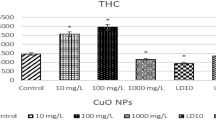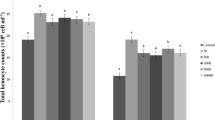Abstract
We studied how biologically relevant trace metals (i.e., micronutrients) in the hemolymph of larval Heliothis virescens and Helicoverpa zea (Lepidoptera: Noctuidae) changed in response to per os baculovirus infection, larval development, and injection of heat-killed bacteria. Concentrations of hemolymph Co, Cr, Cu, Fe, Mg, Mn, Mo, Ni, and Zn were measured using inductively coupled plasma-mass spectrometry. H. virescens larvae exhibited greater fluctuations in hemolymph trace metal levels in response to baculovirus infection and development than did H. zea larvae. H. zea single nucleopolyhedrosis virus infection significantly altered the levels of Cu, Fe, Mg, Mn, Mo, and Zn in fourth instar H. virescens larvae. Conversely, in fifth instar H. virescens and both H. zea instar infections, no metal levels were significantly different between infected and uninfected larvae. In fourth instar H. virescens hemolymph, Cu, Fe, Mo, and Zn increased during development. Cu, Fe, Mg, Mn, Mo, and Zn levels changed significantly during development in fifth instar H. virescens as well as both H. zea instars. Based on this analysis, metals were identified whose levels changed during development in both species and during the immune response of H. virescens larvae.




Similar content being viewed by others
References
Dadd RH (1985) Nutrition: organisms. In: Kerkut GA, Gilbert LI (eds) Comprehensive insect physiology biochemistry and pharmacology, vol. 4. Pergamon Press, Oxford, pp 313–390
Finke MD (2002) Complete nutrient composition of commercially raised invertebrates used as food for insectivores. Zoo Biol 21:269–285
Pereira NR, Ferrarese-Filho O, Matsushita M, de Souza NE (2003) Proximate composition and fatty acid profile of Bombyx mori L. chrysalis toast. J Food Comp Analysis 16:451–457
Zhou L, Chen X, Shao Z, Huang Y, Knight DP (2005) Effect of metallic ions on silk formation in the mulberry silkworm, Bombyx mori. J Phys Chem B 109:16937–16945
Judd TM, Magnus RM, Fasnacht MP (2010) A nutritional profile of the social wasp Polistes metricus: differences in nutrient levels between castes and changes within castes during the annual life cycle. J Insect Physiol 56:42–56
Cho S, Mitchell A, Mitter C, Regier J, Matthews M, Robertson R (2008) Molecular phylogenetics of heliothine moths (Lepidoptera: Noctuidae: Heliothinae), with comments on the evolution of host range and pest status. Sys Entomol 33:581–594
Fitt GP (1989) The ecology of Heliothis species in relation to agroecosystems. Ann Rev Entomol 34:17–52
Weinberg ED (2009) Iron availability and infection. Biochim Biophys Acta 1790:600–605
Munoz C, Rios E, Olivos J, Brunser O, Olivares M (2007) Iron, copper and immunocompetence. British J Nutr 98:S24–S28
Popham HJR, Shelby KS (2006) Uptake of dietary micronutrients from artificial diets by larval Heliothis virescens. J Insect Physiol 52:771–777
Shelby KS, Popham HJR (2007) Dietary selenium supplementation elevates HzSNPV resistance of Heliothis virescens larvae. J Invertebrate Pathol 95:77–83
Popham HJR, Shelby KS, Brandt SL, Coudron TA (2004) Potent virucidal activity against HzSNPV in larval Heliothis virescens plasma. J Gen Virol 85:2225–2261
Shelby KS, Popham HJR (2008) Cloning and characterization of the secreted hemocytic prophenoloxidases of Heliothis virescens. Arch Insect Biochem Physiolol 69:127–142
SAS Institute Inc (2004) SAS/STAT& 9.1 User’s guide. SAS Institute Inc, Cary
Ignoffo CM, McIntosh AH, Garcia C (1983) Susceptibility of larvae of Heliothis zea, H. virescens, and H. armigera [Lep.:Noctuidae] to 3 baculoviruses. BioControl 28:1–8
Trudeau D, Washburn JO, Volkman LE (2001) Central role of hemocytes in Autographa californica MNPV pathogenesis in Heliothis virescens and Helicoverpa zea. J Virol 75:996–1003
Chaturvedi UC, Shrivastava R, Upreti RK (2004) Viral infections and trace elements: a complex interaction. Curr Sci 87:1536–1554
Becnel JJ (2006) Transmission of viruses to mosquito larvae mediated by divalent cations. J Invertebrate Pathol 92:141–145
Shapiro M (2001) The effects of cations on the activity of the gypsy moth (Lepidoptera: Lymantriidae) nuclear polyhedrosis virus. J Econ Entomol 94:1–6
Christian PD, Richards AR, Williams T (2006) Differential adsorption of occluded and nonoccluded insect-pathogenic viruses to soil-forming minerals. Appl Env Microbiol 72:4648–4652
Nichol H, Law JH, Winzerling JJ (2002) Iron metabolism in insects. Ann Rev Entomol 47:535–559
Winzerling JJ, Law JH (1997) Comparative nutrition of iron and copper. Ann Rev Entomol 17:501–526
Winzerling JJ, Pham DQ-D (2006) Iron metabolism in insect disease vectors: mining the Anopheles gambiae translated protein database. Insect Biochem Molec Biol 36:310–321
Bao YY, Li M-W, Zhao Y-P, Ge J-Q, Wang C-S, Huang Y-P, Zhang C-X (2008) Differentially expressed genes in resistant and susceptible Bombyx mori strains infected with a densonucleosis virus. Insect Biochem Molec Biol 38:853–861
Matthijs S, Laus G, Meyer J-M, Abbaspour-Tehrani K, Schafer M, Budzikiewicz H, Cornelis P (2009) Siderophore-mediated iron acquisition in the entomopatho-genic bacterium Psueudomonas entomophila L48 and its close relative P. putida KT2440. Biometals 22:951–964
Dunphy GB, Niven DF, Chadwick JS (2002) Iron contributes to the antibacterial functions of the haemolymph of Galleria mellonella. J Insect Physiol 48:903–914
Prasad AS (2007) Zinc: mechanisms of host defense. J Nutr 137:1345–1349
Matsuo T, Ooe S, Ishikawa Y (1997) Limitation of dietary copper and zinc decreases superoxide dismutase activity in the onion fly, Delia antiqua. Comp Biochem Physiol 117A:191–195
Willot E, Tran HQ (2002) Zinc and Manduca sexta hemocyte functions. J Insect Sci 2:6
Pinheiro DO, Zucchi TD, Zucchi OLAD, Nascimento Filho VF, Almeida E, Consoli FL (2010) Inorganic elements in the fat bodies of Diatraea saccharalis (Lepidoptera: Crambidae) larvae parasitized by Cotesia flavipes (Hymenoptera: Braconidae). Comp Biochem Physiol 156B:273–278
Washburn JO, Kirkpatrick BA, Volkman LE (1996) Insect protection against viruses. Nature 383:767
Shelby KS, Popham HJR (2006) Plasma phenoloxidase of larval Heliothis virescens is virucidal. J Insect Sci 6:13
Popham HJR, Shelby KS, Popham TW (2005) Effect of dietary selenium supplementation on resistance to baculovirus infection. Biol Control 32:419–426
Acknowledgements
We wish to thank Larry Brown and Steve Cooper for their technical assistance. This research was supported in part by the Office of Science (BER) U.S. Department of Energy. This article reports the results of research only and mention of a proprietary product does not constitute an endorsement or recommendation for its use by the USDA.
Author information
Authors and Affiliations
Corresponding author
Rights and permissions
About this article
Cite this article
Popham, H.J.R., Sun, R., Shelby, K.S. et al. Changes in Trace Metals in Hemolymph of Baculovirus-Infected Noctuid Larvae. Biol Trace Elem Res 146, 325–334 (2012). https://doi.org/10.1007/s12011-011-9257-9
Received:
Accepted:
Published:
Issue Date:
DOI: https://doi.org/10.1007/s12011-011-9257-9




